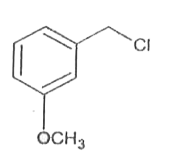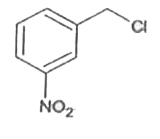Which of the following will react fastest with Ag+




The correct Answer is:B
To determine which compound will react fastest with Ag^+, we need to analyze the substituents on the aromatic ring and their effects on the reactivity of the compound. The reaction involves the abstraction of Cl^- by Ag^+, leading to the formation of a carbocation intermediate.
1. Identify the Compounds: List the compounds provided in the question. For example, let’s assume we have compounds with different substituents like -Cl, -NO2, -OH, and -CH3.
2. Understand the Role of Ag^+: Ag^+ acts as a Lewis acid and will abstract Cl^- from the compound. The stability of the resulting carbocation after the abstraction will determine the rate of reaction.
3. Analyze Substituents:
- Electron-Withdrawing Groups (EWGs): Groups like -NO2 and -Cl withdraw electron density from the aromatic ring, making the carbocation less stable.
- Electron-Donating Groups (EDGs): Groups like -CH3 and -OH donate electron density, stabilizing the carbocation formed after Cl^- abstraction.
4. Consider the Position of Substituents: The position of the substituents (ortho, meta, para) affects their influence:
- At the meta position, resonance effects are not effective for EDGs and EWGs. Thus, the -NO2 group will have a stronger electron-withdrawing effect, while -OH and -CH3 will have a lesser effect.
- At the ortho and para positions, EDGs can stabilize the carbocation through resonance.
5. Determine Reactivity: Based on the analysis:
- The compound with -CH3 or -OH at the ortho or para position will react faster due to the stabilization of the carbocation.
- The compound with -NO2 or -Cl will react slower due to the destabilization of the carbocation.
6. Conclusion: Identify the compound that has the strongest EDG at the ortho or para position, as it will react the fastest with Ag^+.
Final Answer:
The compound with the strongest electron-donating group (like -CH3 or -OH at ortho or para position) will react fastest with Ag^+.
- Electron-Withdrawing Groups (EWGs): Groups like -NO2 and -Cl withdraw electron density from the aromatic ring, making the carbocation less stable.
- Electron-Donating Groups (EDGs): Groups like -CH3 and -OH donate electron density, stabilizing the carbocation formed after Cl^- abstraction.
- At the meta position, resonance effects are not effective for EDGs and EWGs. Thus, the -NO2 group will have a stronger electron-withdrawing effect, while -OH and -CH3 will have a lesser effect.
- At the ortho and para positions, EDGs can stabilize the carbocation through resonance.
- The compound with -CH3 or -OH at the ortho or para position will react faster due to the stabilization of the carbocation.
- The compound with -NO2 or -Cl will react slower due to the destabilization of the carbocation.
The compound with the strongest electron-donating group (like -CH3 or -OH at ortho or para position) will react fastest with Ag^+.
Topper's Solved these Questions
- GENERAL ORGANIC CHEMISTRYBOOK - FIITJEECHAPTER - GENERAL ORGANIC CHEMISTRYEXERCISE - Section (II) [Jee mains]: With Single Correct Choice
78 Videos
- GENERAL ORGANIC CHEMISTRYBOOK - FIITJEECHAPTER - GENERAL ORGANIC CHEMISTRYEXERCISE - MORE THAN ONE CORRECT CHOICES
24 Videos
- GENERAL ORGANIC CHEMISTRYBOOK - FIITJEECHAPTER - GENERAL ORGANIC CHEMISTRYEXERCISE - SINGLE INTEGER ANSWER TYPE QUESTIONS
14 Videos
- GASEOUS STATEBOOK - FIITJEECHAPTER - GASEOUS STATEEXERCISE - MATCHING LIST TYPE QUESTION
1 Videos
- HYDROCARBONSBOOK - FIITJEECHAPTER - HYDROCARBONSEXERCISE - SINGLE INTEGER ANSWER TYPE QUESTION
9 Videos
Similar Questions
Knowledge Check
Which of the following reacts fastest with HBr?
A B
B C
C D
D
Which of the following reacts fastest with HBr?
A B
B C
C D
D
Which of the following will react fastest with Lucas reagent?
AButan-1-olBButan-2-olC2-Methylpropan-2-olD2-Methylpropan
